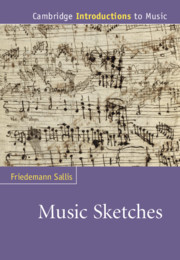Book contents
- Frontmatter
- dedication
- Contents
- List of figures
- List of music examples
- List of tables
- Preface
- Chapter 1 Introduction
- Chapter 2 Sketch studies past and present
- Chapter 3 Tracking down evidence of the creative process
- Chapter 4 The physical objects of the compositional process
- Chapter 5 Studying loose leaves
- Chapter 6 Sketchbooks
- Chapter 7 Transcription and facsimile reproduction
- Chapter 8 Sketches and the critical edition of music
- Chapter 9 Dangerous liaisons: the evolving relationship between sketch studies and analysis
- Chapter 10 Musical palimpsests and authorship
- Appendix: Beethoven sketchbooks published between 1913 and 2013
- Notes
- Glossary
- Bibliography
- Index
Chapter 8 - Sketches and the critical edition of music
Published online by Cambridge University Press: 05 February 2015
- Frontmatter
- dedication
- Contents
- List of figures
- List of music examples
- List of tables
- Preface
- Chapter 1 Introduction
- Chapter 2 Sketch studies past and present
- Chapter 3 Tracking down evidence of the creative process
- Chapter 4 The physical objects of the compositional process
- Chapter 5 Studying loose leaves
- Chapter 6 Sketchbooks
- Chapter 7 Transcription and facsimile reproduction
- Chapter 8 Sketches and the critical edition of music
- Chapter 9 Dangerous liaisons: the evolving relationship between sketch studies and analysis
- Chapter 10 Musical palimpsests and authorship
- Appendix: Beethoven sketchbooks published between 1913 and 2013
- Notes
- Glossary
- Bibliography
- Index
Summary
Editorial practice and the strong work concept
In his book on the critical edition of music, James Grier boldly asserts that, though they may contain useful information, in most cases sketches do not materially affect the text of the edition. With that, the documents composers produce in working through their ideas are summarily dismissed to the margins of editorial practice. The statement is curious, because Grier begins his book with a presentation of the well-known case from the re-transition in the first movement of the Hammerklavier, Sonata in B flat major, Op. 106 (bars 224–6). Two different sketches show Beethoven writing an A natural, but the first edition (published during his lifetime) gives an A sharp. To be sure, the information provided by the sketches is inconclusive. No autograph fair copy survives and, even if it did, he could still have decided to change the A natural to A sharp later in the publication process. William Kinderman believes that Beethoven simply forgot to add the natural signs while copying the score, leaving the A sharp by mistake. Charles Rosen agrees, but also believes that the error was a stroke of genius, suggesting that it was caused by Beethoven’s musical subconscious. Clearly, whether the outcome agrees with the sketches or not, no one can argue that the information they provide has not had an impact on the editorial preparation of this text.
- Type
- Chapter
- Information
- Music Sketches , pp. 137 - 160Publisher: Cambridge University PressPrint publication year: 2015

